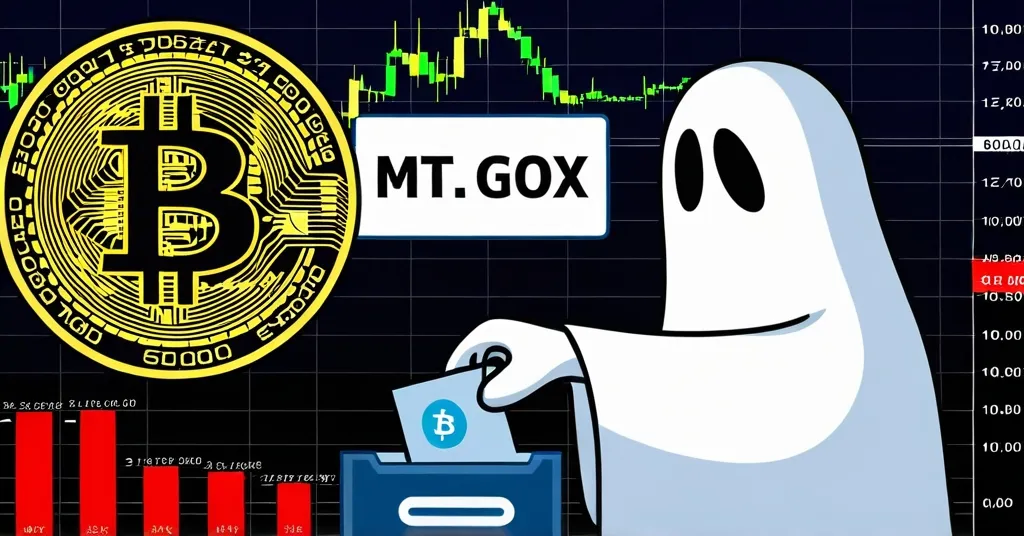Mt. Gox Transfers 11,834 BTC Amid Bitcoin Crash to $76,000

Amid Market Turmoil, Mt. Gox Moves 11,834 Bitcoins to New Wallets
As Bitcoin tumbles to $76,000 and Ethereum dips below $1,800, the ghost of Mt. Gox stirs once more, moving 11,834 Bitcoins to new wallets and adding fuel to an already volatile market.
- Mt. Gox transferred about 11,834 BTC
- Bitcoin fell to $76,000, Ethereum under $1,800
- Repayment deadline extended to October 31, 2024
Recent Transfers
Mt. Gox, the once-dominant Bitcoin exchange that collapsed in 2014, has recently transferred approximately 11,834 Bitcoins amidst a severe cryptocurrency market crash. Of these, 11,502 BTC were moved to a new wallet, while the remaining 332 BTC were sent to a warm wallet—a type of cryptocurrency wallet connected to the internet for faster transactions. These transfers follow previous movements this month, including a significant $1.07 billion transfer and a smaller $15 million transfer, all part of Mt. Gox’s ongoing efforts to repay its creditors. The process, which began in July 2023, is a slow and meticulous effort to restore some trust and compensate affected users.
Market Reaction
The broader market correction has seen Bitcoin crash to $76,000 and Ethereum fall below $1,800, marking the lowest levels since October 2023. This period of declining prices, known as a market correction, occurs after significant rises and aims to return to more sustainable levels. Despite fears that Mt. Gox’s creditor repayments might trigger a major market correction, the market has so far remained relatively stable. Arthur Hayes, Chief Investment Officer at Maelstrom, recently advised investors to remain patient, predicting that Bitcoin would bottom around the $70,000 mark, offering a glimmer of hope amidst the ongoing turmoil. Meanwhile, analysts from Arkham Intelligence noted that the movement of Bitcoin to an “operations wallet”—used for managing day-to-day activities of an exchange—could be a precursor to further distribution to creditors, signaling more market activity on the horizon.
Historical Context
Before its infamous downfall, Mt. Gox was a juggernaut, handling roughly 70-80% of global Bitcoin trading volume. Its collapse due to a massive hack sent major disruptions through the cryptocurrency market, leading to significant losses and a loss of trust in crypto exchanges. The ongoing repayments are a long-term effort to restore some of that lost trust. The collapse of Mt. Gox also prompted regulatory changes and heightened security standards within the crypto industry, illustrating the need for robust security measures and transparent operations in crypto exchanges.
Future Implications
The final repayment deadline for Mt. Gox has been postponed to October 31, 2024, aiming to ease immediate selling pressure but keeping the crypto community on edge. BitGo, a crypto custodian, plays a crucial role in facilitating these repayments. The transfer of $15 million to BitGo suggests ongoing preparations for distributing assets to creditors. However, with Mt. Gox-linked wallets still holding an estimated $2.9 billion worth of BTC, the journey to full repayment is far from over. This situation underscores the complexities of managing cryptocurrency assets in bankruptcy and highlights the need for better security measures in the crypto world.
Security and Decentralization
The Mt. Gox collapse highlighted the vulnerabilities of centralized exchanges, emphasizing the need for decentralization and robust security measures. While warm wallets offer convenience for transactions, their internet connectivity poses security risks compared to cold storage, which keeps assets offline and thus more secure. The ongoing saga of Mt. Gox serves as a stark reminder of the risks inherent in the crypto world, yet it also demonstrates the resilience and potential for recovery within this revolutionary space.
Counterpoints and Critical Thinking
Some might argue that the market’s reaction to Mt. Gox’s transfers is overblown, given the broader market trends. The movements, while significant, are just one piece of a much larger puzzle in the volatile crypto market. It’s like watching a horror movie where the ghost you thought was gone comes back for one last scare—but perhaps the market’s fears are more about the general uncertainty than the specific actions of Mt. Gox.
Bitcoin Maximalist and E/Acc Perspectives
Bitcoin maximalists might view Mt. Gox’s situation as a testament to Bitcoin’s resilience despite early setbacks. The ongoing repayments and market stability reflect the strength and adaptability of Bitcoin. From an effective accelerationism (e/acc) perspective, the Mt. Gox saga pushes the industry to evolve and improve after such failures, driving innovation and better security measures in the crypto space.
“Mt. Gox always finds a way to keep the market nervous,” an X user commented in response.
Key Takeaways and Questions
- What did Mt. Gox do recently?
Mt. Gox transferred approximately 11,834 Bitcoins, with the majority going to a new wallet and the rest to a warm wallet.
- How did Bitcoin and Ethereum prices react during this period?
Bitcoin crashed to $76,000, and Ethereum fell below $1,800, marking the lowest levels since October 2023.
- When is the new final repayment deadline for Mt. Gox?
The new final repayment deadline for Mt. Gox is October 31, 2024.
- What was the impact of Mt. Gox’s creditor repayments on the market?
Despite some concerns, Mt. Gox’s creditor repayments have not caused a major market correction.
- What was Mt. Gox’s role in the global Bitcoin market before its collapse?
Before its collapse, Mt. Gox handled around 70-80% of the global Bitcoin trading volume.
- How does Mt. Gox’s situation reflect on the need for decentralization and better security in crypto exchanges?
The Mt. Gox collapse highlighted the vulnerabilities of centralized exchanges, emphasizing the need for decentralization and robust security measures.



